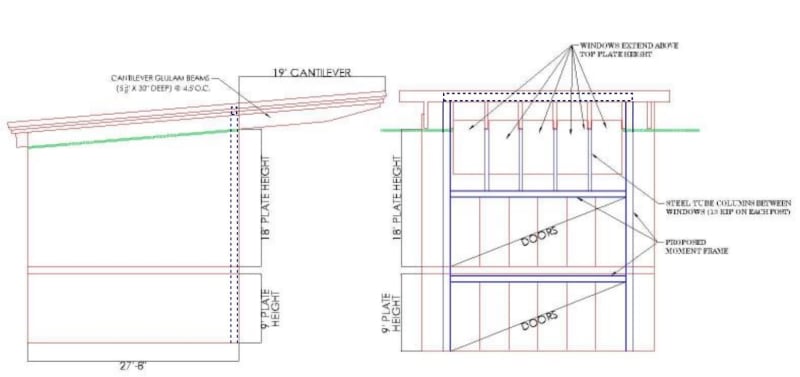Ashke15
Structural
- Mar 9, 2023
- 16
Hi all,
Working on a residential structure that suddenly got way more complicated after a bunch of changes from the owner. A quick rundown of the project:
- Rectangular wood-framed structure
- Tall main floor (18' plate height at the tall end)
- Concrete foundation walls for 9' basement with framed walkout at the rear
- Glulam beams form the roof and cantilever out 19'. Rafters run over the top of the glulams
- Top plate at the front and rear is broken by windows that stick up above the top plate
Problem #1: I had originally planned on a steel moment frame at the back of the structure. Previously the windows did not stick up through the top plate so this would have been easy. Now I can't get a steel beam over the top of the windows for the frame. See the sketch below for a new proposed steel frame. Wondering if it's ok to say that the lateral load from roof diaphragm goes into the glulam beams, then into the steel columns between the windows, then into a lower steel beam over the doors.
Problem #2: The glulam beams originally cantilevered out 5'. Now they go out 19'....I've got 5 1/8" x 30" glulam beams to work. However, I'm thinking they need to be laterally braced at the cantilever to prevent twisting, but not sure how to do that since I'm sure they won't want to see bracing between the glulams. Also, I've never done a cantilever even close to this long and am thinking I'm probably missing something.
Any thoughts on these issues I'm facing on this project? I appreciate any advice or feedback that you may have.

Working on a residential structure that suddenly got way more complicated after a bunch of changes from the owner. A quick rundown of the project:
- Rectangular wood-framed structure
- Tall main floor (18' plate height at the tall end)
- Concrete foundation walls for 9' basement with framed walkout at the rear
- Glulam beams form the roof and cantilever out 19'. Rafters run over the top of the glulams
- Top plate at the front and rear is broken by windows that stick up above the top plate
Problem #1: I had originally planned on a steel moment frame at the back of the structure. Previously the windows did not stick up through the top plate so this would have been easy. Now I can't get a steel beam over the top of the windows for the frame. See the sketch below for a new proposed steel frame. Wondering if it's ok to say that the lateral load from roof diaphragm goes into the glulam beams, then into the steel columns between the windows, then into a lower steel beam over the doors.
Problem #2: The glulam beams originally cantilevered out 5'. Now they go out 19'....I've got 5 1/8" x 30" glulam beams to work. However, I'm thinking they need to be laterally braced at the cantilever to prevent twisting, but not sure how to do that since I'm sure they won't want to see bracing between the glulams. Also, I've never done a cantilever even close to this long and am thinking I'm probably missing something.
Any thoughts on these issues I'm facing on this project? I appreciate any advice or feedback that you may have.


